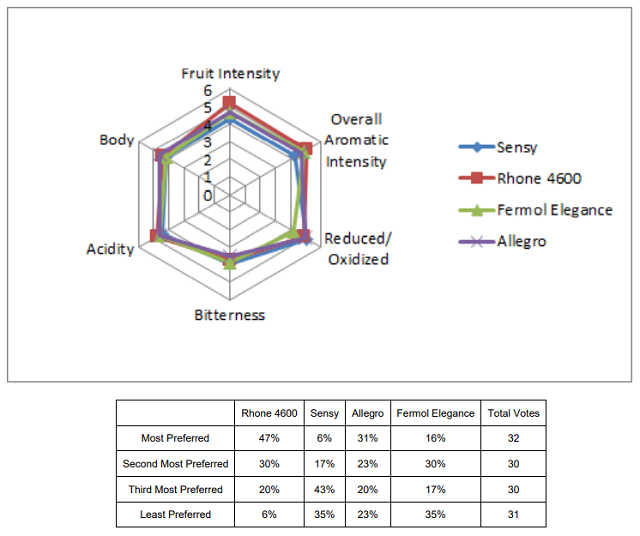H2S Production by Different Low-H2S Producing Yeast Strains (2016)
Theo Smith
Rappahannock Cellars
Summary
This study examines the effect of different low H2S-producing yeast strains on the sensory attributes of Cabernet Franc and Cabernet Sauvignon Rosé. The grapes were harvested on the same day, pressed together, and after settling was racked into four different 484L puncheons (2006 Hungarian oak from the same cooper). The barrels were inoculated with the following yeasts: Rhône 4600 (ScottLabs), Allegro (Phyterra), Sensy (ScottLabs), and Fermol Elegance (AEB). Rhône 4600 is not marketed as a low H2S-producing yeast strain and was intended to act as a soft control. The strains showed similar fermentation kinetics except for Rhône 4600, which was markedly slower. Additionally, the wine produced by Rhône 4600 had a higher alcohol content and higher total SO2, possibly from yeast production. The sulfide contents of the wines, however, were essentially indistinguishable. No strong trends were found with the descriptors used for this study. Rhône 4600 tended to show higher Fruit Intensity and Overall Aromatic Intensity. Many of these wines were perceived as slightly reduced. In general, people tended to prefer wines produced with Rhône 4600 and Allegro yeasts.
Introduction
Hydrogen sulfide, even at very low levels, can alter the sensory qualities of wine. Thus, its control in winemaking is a very important quality factor. Although some people find reductive qualities to add complexity to a wine, in general these qualities are often perceived as negative. This study examines the impact of 3 different yeast strains marketed for being low sulfide producers on rosé wine, and compares them to a yeast strain not marketed to be a low sulfide producer.
Results and Discussion
The Sensey and Rhône 4600 fermentations smelled reductive on their third day, and the Fermoplus Elegance fermentation smelled reductive on day four. The Allegro yeast did not produce reductive aromas during fermentation. The strains showed similar fermentation kinetics except for Rhône 4600, which was markedly slower. Additionally, the wine produced by Rhône 4600 had a higher alcohol content and higher total sulfur dioxide, possibly from yeast production. The sulfide contents of the wines, however, were essentially indistinguishable. No strong trends were found with the descriptors used for this study.


No strong trends were found with the descriptors used for this study. Rhône 4600 tended to show higher Fruit Intensity and Overall Aromatic Intensity. Many of these wines were perceived as slightly reduced. In general, people tended to prefer wines produced with Rhône 4600 and Allegro yeasts.

Methods
1.72 tons of Cabernet Franc and 1.63 tons of Cabernet Sauvignon were harvested from the Reality Farms Vineyard on 10/4 and pressed together. 30ppm sulfur dioxide and 80mL/ton Color Pro were added to the pressings. The wines were pressed into a settling tank and were transferred the following day to 4 different 484L puncheons. All puncheons were 2006 Hungarian oak from the same cooper. On 10/5 each puncheon was inoculated with 25g/hL of each yeast from the trial, rehydrated with 30ghL GoFerm. The following yeasts were used:
- BBL 1: Scott Labs, Rhône 4600 (control)
- BBL 2: Phyterra, Allegro
- BBL 3: Scott Labs, Sensey
- BBL 4: AEB, FermoPlus Elegance
On 10/7, 1.6g/L tartaric acid was added to each fermentation. On 10/26 the wine was stabilized with 60ppm sulfur dioxide. Wine from each treatment was topped with a chardonnay press fraction wine, pH 3.69.
The wines were tasted on March 8. In order to balance the data set to perform statistical analysis for descriptive analysis, any judge who had not fully completed the descriptive analysis ratings were removed. In order to then make the amount of judges between groups equivalent, one judge from group 1 was transferred to group 3. This resulted in a final data set of 3 groups, each with 10 judges (considered as replications within groups, and groups were considered as assessors). Data was analyzed using Panel Check V1.4.2. Because this is not a truly statistical set-up, any results which are found to be statistically significant (p<0.05) will be denoted as a “strong trend” or a “strong tendency,” as opposed to general trends or tendencies. The statistical significance here will ignore any other significant effects or interactions which may confound the results (such as a statistically significant interaction of Judge x Wine confounding a significant result from Wine alone). The descriptors used in this study were Fruit Intensity, Overall Aromatic Intensity, Reduced/Oxidized (on a scale from most reduced to most oxidized), Bitterness, Acidity, and Body.
